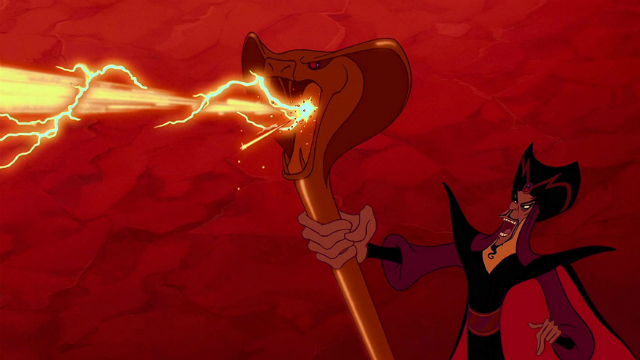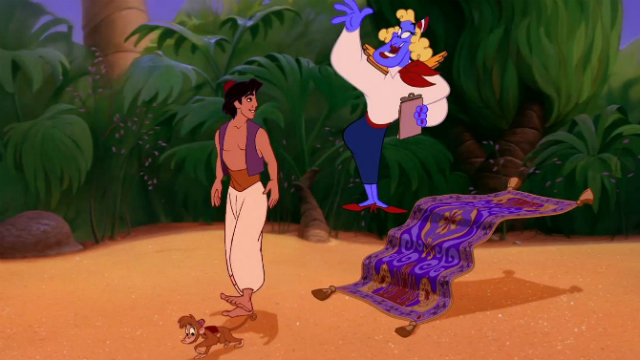Odds are there are two things most people remember about Disney’s Aladdin. The “Whole New World” song on the flying carpet, and Robin Williams’ madcap riffing as the Genie. Maybe Gilbert Gottfried voicing a parrot is a distant third, depending on your tolerance for shouty comedians. These are indeed highlights, and yet, if that’s all you remember, then you’re still doing Aladdin a disservice. But it’s okay. The movie is so consistently entertaining that a viewer doesn’t always consciously see how the sausage is made. But there’s so much more to it than just the highlights that stick in your head.
Rival studios also took the wrong message from Aladdin. They saw Robin Williams make pop-culture references, and for years afterwards we were cursed with cartoons shoehorning fourth-wall breaking impersonations where they didn’t belong. Disney’s Aladdin isn’t great because it makes jokes about celebrities; it’s great because they let Williams run his mouth unchecked. In fact, some of his impersonations are so obscure as to be pointless, except as means to make him happy and enthused. Also, literally no kid in 1992 or today can appreciate a William F. Buckley impersonation. (On a Blu-ray extra explaining “all” his impersonations, that’s one they leave out entirely.)
RELATED: Review: It Chapter Two Brings Scary Therapy
The reason Genie succeeds as a character is that Williams poured heart and soul into that part. Even when it veers into weird tangents, it’s honest. That’s what plays. But that’s certainly not the only thing in the movie which does. Aladdin was actually the Disney animated film that won me back to Disney as a teen. As I was a surly sixteen year-old, The Little Mermaid and Beauty and the Beast did not appeal. But this one changed my tune.

Aladdin in its day integrated CG in a way that seemed very futuristic. Today, there’s one digital shot during the Cave of Wonders escape that is super-cheese. But the cave’s emergence from the sand, and that magic carpet, no longer look as out of place as they used to, now that cel-shading is a totally routine thing. What catches the eye now are the retro throwbacks. The initial “One Jump” sequence, with Aladdin evading palace guards, used parkour in Hollywood before it was a thing. It also incorporates many Looney Tunes-style gags that might seem overly broad in a modern animated film. For all its more serious moments, this cartoon remembers that it’s a cartoon first and foremost.
RELATED: Review: 1990 Movie Teenage Mutant Ninja Turtles Figure Set
The story really feels incredibly simple. Basically: boy meets girl, boy dresses up to impress girl, boy falls victim to villain, boy defeats villain, boy gets girl. It’s a classic fairy-tale framework on which to hang musical numbers and gags, reminiscent of a simpler time for Disney. The modern fairy tale movies with princess have to pretend they’re something else, with Rapunzel becoming Tangled and The Snow Queen as Frozen. Even their plots aren’t so straightforward any more. Aladdin was exactly as promised: genie, lamp, flying carpet, princess. And Jonathan Freeman’s bass-enhanced voice as the evil Jafar. It’s no shock that even in an age of more ethnically sensitive casting, Freeman has retained the role on Broadway for years.
Aladdin in 4K looks great, but it’s hard to say that it looks significantly better than it already did in regular high definition. With hand-drawn animation, there’s only so much clarity you can possibly get. The altered lyrics in the opening “Arabian Nights” number remain altered — Disney will always choose family friendly updates over perceived purity of the original release. So there’s no talk of cutting off ears here.
RELATED: Iron Man 3 in 4K – Best Marvel PTSD Before Fat Thor
The previous Blu-ray came loaded with forty-some extras, all of which are retained here, in addition to three more. Newly unearthed storyboards of an alternate ending once again show that the original plan was to reveal the Robin Williams-voiced merchant in the beginning was Genie in disguise. Another new featurette has a fun montage of scenes from the recording both, showcasing every major actor at the microphone.

However, he highlight of the new extras is a short documentary in which Aladdin’s speaking (but not singing) voice Scott Weinger tracks down most of his fellow castmates for new interviews. In a touching finale, composer Alan Menken even manages to teach Weinger how to sing.
It seems odd to release this alongside the live-action remake. I’m no marketing wizard, but putting out the remake first might have created more anticipation for the original to come back. Perhaps they’re counting on consumer confusion, and parents or kids not knowing the difference. Anyone buying the remake probably wants the original as well, but vice versa is no certainty.
Buy/Rent/Pass? Buy. Aladdin is a stone-cold classic of animation, and the new extras make for good and fun additions.





